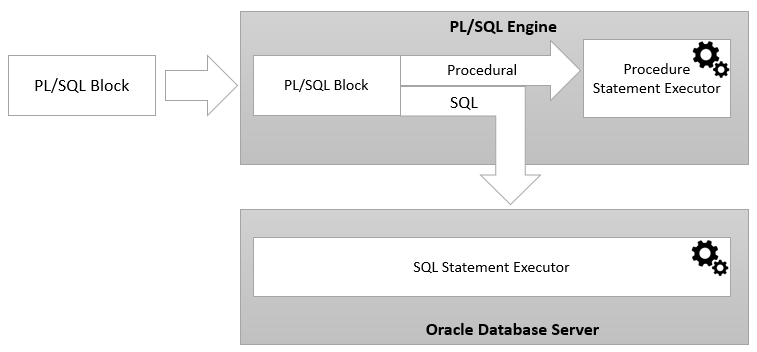Introduction to PL/SQL
PL/SQL stands for “Procedural Language extensions to the Structured Query Language”. SQL is a popular language for both querying and updating data in the relational database management systems (RDBMS). PL/SQL adds many procedural constructs to SQL language to overcome some limitations of SQL. Besides, PL/SQL provides a more comprehensive programming language solution for building mission-critical applications on Oracle Databases. PL/SQL is a highly structured and readable language. Its constructs express the intent of the code clearly. Also, PL/SQL is a straightforward language to learn. PL/SQL is a standard and portable language for Oracle Database development. If you develop a program that executes on an Oracle Database, you can quickly move it to another compatible Oracle Database without any changes. PL/SQL is an embedded language. PL/SQL only can execute in an Oracle Database. It was not designed to use as a standalone language like Java, C#, and C++. In other words, you cannot develop a PL/SQL program that runs on a system that does not have an Oracle Database. PL/SQL is a high-performance and highly integrated database language. Besides PL/SQL, you can use other programming languages such as Java, C#, and C++. However, it is easier to write efficient code in PL/SQL than other programming languages when it comes to interacting with the Oracle Database. In particular, you can use PL/SQL specific constructs like the FORALL statement that helps improve database performance.
____________________________________________________________________________
PL/SQL architecture
The following picture illustrates the PL/SQL architecture:

PL/SQL engine is in charge of compiling PL/SQL code into byte-code and executes the executable code. The PL/SQL engine can only be installed in an Oracle Database server or an application development tool such as Oracle Forms.
Once you submit a PL/SQL block to the Oracle Database server, the PL/SQL engine collaborates with the SQL engine to compile and execute the code. PL/SQL engine runs the procedural elements while the SQL engine processes the SQL statements.
____________________________________________________________________________________
PL/SQL is a block structured language that enables developers to combine the power of SQL with procedural statements.All the statements of a block are passed to oracle engine all at once which increases processing speed and decreases the traffic.
Disadvantages of SQL:
- SQL doesn’t provide the programmers with a technique of condition checking, looping and branching.
- SQL statements are passed to Oracle engine one at a time which increases traffic and decreases speed.
- SQL has no facility of error checking during manipulation of data.
Features of PL/SQL:
- PL/SQL is basically a procedural language, which provides the functionality of decision making, iteration and many more features of procedural programming languages.
- PL/SQL can execute a number of queries in one block using single command.
- One can create a PL/SQL unit such as procedures, functions, packages, triggers, and types, which are stored in the database for reuse by applications.
- PL/SQL provides a feature to handle the exception which occurs in PL/SQL block known as exception handling block.
- Applications written in PL/SQL are portable to computer hardware or operating system where Oracle is operational.
- PL/SQL Offers extensive error checking.
Differences between SQL and PL/SQL:
| SQL | PL/SQL |
| SQL is a single query that is used to perform DML and DDL operations. | PL/SQL is a block of codes that used to write the entire program blocks/ procedure/ function, etc. |
| It is declarative, that defines what needs to be done, rather than how things need to be done. | PL/SQL is procedural that defines how the things needs to be done. |
| Execute as a single statement. | Execute as a whole block. |
| Mainly used to manipulate data. | Mainly used to create an application. |
| Cannot contain PL/SQL code in it. | It is an extension of SQL, so it can contain SQL inside it. |
Structure of PL/SQL Block:
PL/SQL extends SQL by adding constructs found in procedural languages, resulting in a structural language that is more powerful than SQL. The basic unit in PL/SQL is a block. All PL/SQL programs are made up of blocks, which can be nested within each other.

Typically, each block performs a logical action in the program. A block has the following structure:
DECLARE
declaration statements;
BEGIN
executable statements
EXCEPTIONS
exception handling statements
END;
- Declare section starts with DECLARE keyword in which variables, constants, records as cursors can be declared which stores data temporarily. It basically consists definition of PL/SQL identifiers. This part of the code is optional.
- Execution section starts with BEGIN and ends with END keyword.This is a mandatory section and here the program logic is written to perform any task like loops and conditional statements. It supports all DML commands, DDL commands and SQL*PLUS built-in functions as well.
- Exception section starts with EXCEPTION keyword.This section is optional which contains statements that are executed when a run-time error occurs. Any exceptions can be handled in this section.
PL/SQL identifiers
There are several PL/SQL identifiers such as variables, constants, procedures, cursors, triggers etc.
Variables:
Like several other programming languages, variables in PL/SQL must be declared prior to its use. They should have a valid name and data type as well.Syntax for declaration of variables:
variable_name datatype [NOT NULL := value ];
Example to show how to declare variables in PL/SQL :
Output:
PL/SQL procedure successfully completed.
Explanation:
- SET SERVEROUTPUT ON: It is used to display the buffer used by the dbms_output.
- var1 INTEGER : It is the declaration of variable, named var1 which is of integer type. There are many other data types that can be used like float, int, real, smallint, long etc. It also supports variables used in SQL as well like NUMBER(prec, scale), varchar, varchar2 etc.
- PL/SQL procedure successfully completed.: It is displayed when the code is compiled and executed successfully.
- Slash (/) after END;: The slash (/) tells the SQL*Plus to execute the block.
1.1) INITIALISING VARIABLES:
The variables can also be initialised just like in other programming languages. Let us see an example for the same:Output:
PL/SQL procedure successfully completed.
Explanation:
- Assignment operator (:=) : It is used to assign a value to a variable.
Displaying Output:
The outputs are displayed by using DBMS_OUTPUT which is a built-in package that enables the user to display output, debugging information, and send messages from PL/SQL blocks, subprograms, packages, and triggers.Let us see an example to see how to display a message using PL/SQL :
Output:
I love Bigdata 7x PL/SQL procedure successfully completed.
Explanation:
- dbms_output.put_line : This command is used to direct the PL/SQL output to a screen.
Using Comments:
Like in many other programming languages, in PL/SQL also, comments can be put within the code which has no effect in the code. There are two syntaxes to create comments in PL/SQL :- Single Line Comment: To create a single line comment , the symbol – – is used.
- Multi Line Comment: To create comments that span over several lines, the symbol /* and */ is used.
Example to show how to create comments in PL/SQL :
Output:
I love Bigdata 7x PL/SQL procedure successfully completed.
Taking input from user:
Just like in other programming languages, in PL/SQL also, we can take input from the user and store it in a variable. Let us see an example to show how to take input from users in PL/SQL:Output:
Enter value for a: 24 old 2: a number := &a; new 2: a number := 24; Enter value for b: 'bigdata7x' old 3: b varchar2(30) := &b; new 3: b varchar2(30) := 'Bigdata7x'; PL/SQL procedure successfully completed.
- (***) Let us see an example on PL/SQL to demonstrate all above concepts in one single block of code.
Enter value for a: 2 Enter value for b: 3 Sum of 2 and 3 is = 5 PL/SQL procedure successfully completed.
PL/SQL Execution Environment:
The PL/SQL engine resides in the Oracle engine.The Oracle engine can process not only single SQL statement but also block of many statements.The call to Oracle engine needs to be made only once to execute any number of SQL statements if these SQL statements are bundled inside a PL/SQL block.










